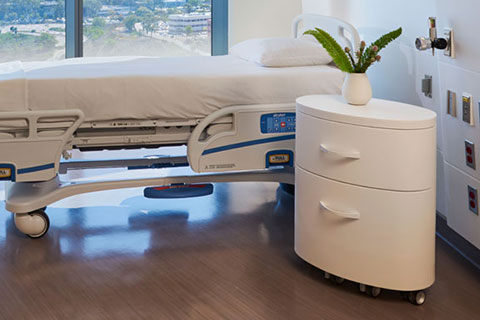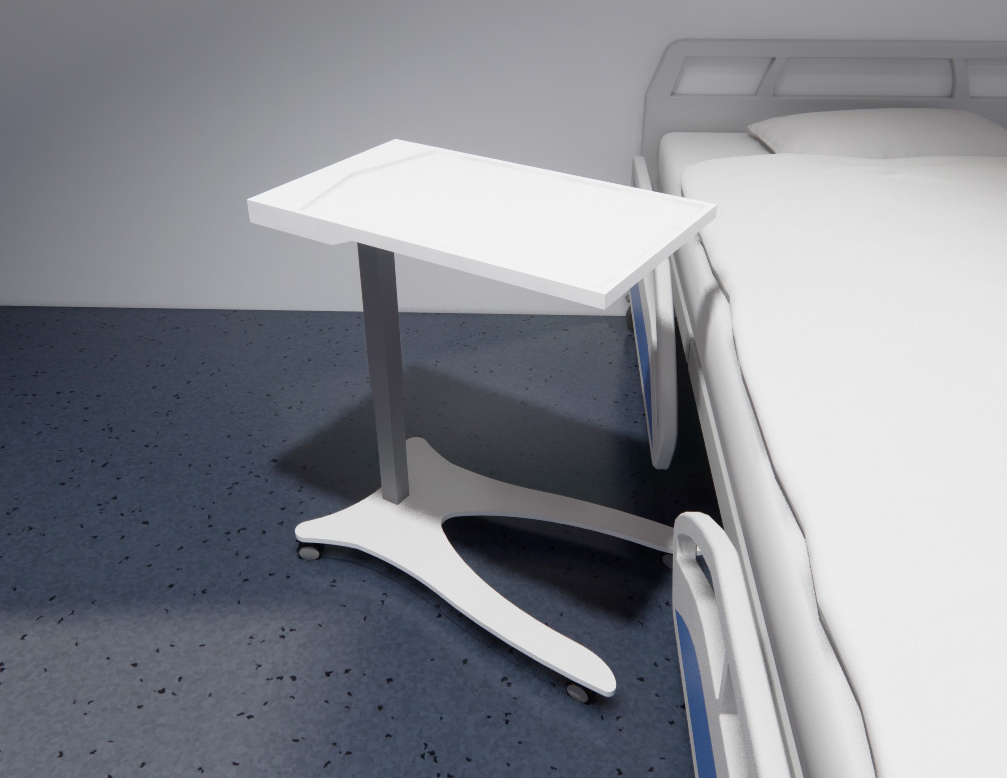The Best Non-Porous Material that Keeps Healthcare Furniture Safe

Within our blog series surrounding the five furniture surface characteristics we have shown that the most important aspects of healthcare furniture includes the following; durability, cleanability, inability to support microbial growth, surface porosity and absence of seams. These characteristics were defined by the American Society of Healthcare Engineering (ASHE) in collaboration with the CDC in the publication titled Using the Health Care Physical Environment to Prevent and Control Infection. Our past blogs have covered why durability and cleanability make a huge difference in healthcare as well as why acrylic solid surface is one of the best choices in upholding these standards.
In this post we will be covering surface porosity. What it is, how it is defined and why it is so important to make sure the material you choose for your furniture can withstand any fluids or debris that might be thrown its way?
What is Surface Porosity?
Simply put, surface porosity is how much of a minute space a material may have that allows liquid, air or other bacteria to pass through. When working in a healthcare setting, the ideal material would be one that could block outside substances in order to minimize the passing of healthcare-associated infections (HAI’s), as well as the risk that the piece will degrade from the inside out.
As Mississippi State University reports within a study on the effects of porosity on mechanical material properties, “The displayed curves suggest an inverse relationship between the porosity and the strength of the material. The relationship indicates that the voids will weaken the material as more are present in the microstructure.”
To find the porosity of an item, we take the void volume which is the space in a material that is not occupied by particles and divide that by the total volume. Common materials used in furniture such as stainless steel and laminates tend to have a porosity of around 5%-27%. (1) (2) Though lower than other materials, we still see room for eventual degradation within these elements. While these materials can create products that look aesthetically pleasing, for a healthcare setting aesthetics can only matter if the durability and safety of a piece can hold up over time.
Common materials used in furniture such as stainless steel and laminates tend to have a porosity of around 5%-27%. Though lower than other materials, we still see room for eventual degradation within these elements.
Why Acrylic Solid Surface?
Think of any medical television show; Grey’s anatomy, House, Scrubs… What is the first thing that comes to your mind? Perhaps it’s a big stainless steel table holding tons of tools. In fact, you may be wondering to yourself, why not just use stainless steel? It’s non-porous and tends to be a go-to when making furniture for healthcare.

Acrylic solid surface is made of two main components; aluminum trihydrate (ATH) and polymethyl methacrylate (PMMA), more commonly known as acrylic. When put together, both of these components make a material that is incredibly malleable and easily thermoformed, which is a process that allows sheets of material to be heated to a pliable temperature and then be trimmed and molded.
With stainless steel it is much more common to use a process called injection molding. Unlike thermoforming where the material is heated and then molded and trimmed into whatever shape is desired, injection molding means the material must be melted and placed into an already formed mold. This means that with stainless steel you are not only much more limited in what you can create but you add more time and difficulty in product production. Stainless steel also has higher production cost due to the addition of other materials such as iron, nickel, copper and chromium that act as bonding elements in manufacturing.
As reported by Rodon Group, "Injection mold tooling is more time-consuming, as the molds are double-sided and composed of harder materials such as steel. Comparatively, thermoform molds are easier to design, fabricate, and modify, making them the ideal for development and testing."
Injection mold tooling is more time-consuming, as the molds are double-sided and composed of harder materials such as steel. Comparatively, thermoform molds are easier to design, fabricate and modify.
Low Porosity means Low Stress
Walking into a hospital isn’t necessarily a fun process. Individuals may be entering due to sick loved ones, an unknown pain or trying to figure out what their life may look like with a brand new baby. The last thing anybody needs in those situations is to feel like their hospital is uninviting.
Stainless steel can often look cold and stark, which may not be the first thing patients want to see. Other building materials like laminates or plastics may be able to create more aesthetically pleasing designs, but at the cost of degrading over time. With acrylic solid surface it is easy to know that your products can be both welcoming and durable due largely to being non-porous, reassuring patients that they and their loved one will stay protected from HAI’s.
As reported by ASHE, "Developing design strategies intended to prevent the transmission of infection when building or renovating health care facilities requires a fundamental understanding of how infections are spread."
With acrylic solid surface it is easy to know that your products can be both welcoming and durable.
But low stress doesn’t end with the patient, it also includes the nurses and doctors whose health and safety is vital to the functioning of a healthcare setting as well as the bank accounts of those who provide funding.
Non-porous materials mean less work and less costs for hospitals as a whole. In the wake of COVID-19 it is more important than ever for workers to know their furniture is not harboring bacteria. Hundreds of patients enter day in and day out and surfaces need to be cleaned in a timely manner. When one patient leaves a room, another may come in a matter of minutes and disinfecting needs to be an efficient process.
Knowing your material creates efficient processes and will not break down creates peace of mind when it comes to saving costs. Instead of thinking about having to replace a bedside table every few months, you can budget for years and put funds elsewhere.
As ASHE reports, "Apart from fostering more positive health outcomes, building health care environments in a way that conscientiously addresses the issue of HAI's can also prove to be more financially sustainable."
To stay informed on this blog series and the latest innovations in acrylic solid surface design, join to our mailing list.
Do you have a design project that you think would be well-suited for acrylic solid surface? Contact Shield to learn more about our custom design services or visit our products page for more information.
1. Hardin, R.A., and C. Beckermann. “Effect of Porosity on Deformation, Damage, and Fracture of Cast Steel.” Springer Link, Springer Link, 28 February 2013, https://link.springer.com/article/10.1007/s11661-013-1669-z#:~:text=Steel%20plates%20containing%20shrinkage%20porosity,from%200.10%20to%200.27%20pct. Accessed 8 February 2023.
2. Poudel, Anish & Sandhu, Jaswinder & Chu, Tsuchin & Pergantis, Charles. (2014). Porosity Measurement in Carbon Fiber Epoxy Laminates by Using Acoustography.
